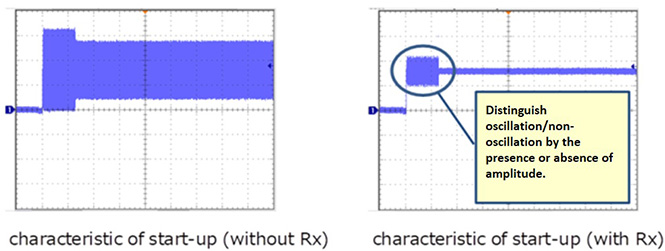Oscillation Circuit Evaluation Methods
"Negative Resistance"(6) <Start-up characteristics>
With the AGC (Auto Gain Control) function, some ICs have a large gain only when the crystal unit starts to oscillates (hereinafter referred as start-up).
In the case of an oscillation circuit using such IC type, the start-up negative resistance is generally larger than the steady-state negative resistance.
Therefore, in the case of an oscillation circuit using an IC of the type described above, not only the steady-state negative resistance but also the start-up negative resistance are measured and evaluated.
In this case, the judgment is made based on whether or not the "negative resistance at start-up" meets the negative resistance target value (see What is "Negative Resistance" (1) ).
(If the start-up negative resistance meets the target, there is sufficient margin for oscillation starting, and if the steady-state negative resistance is sufficiently large with respect to the load equivalent resistance RL of the crystal unit, oscillation can be maintained after starting even if the target value cannot be secured.)
"The following describes how to measure the negative resistance at start-up.
Since the time period while large gain (which is negative resistance at start-up) is kept, is usually as short as several milliseconds or less, it is difficult to measure the oscillation at start-up with a spectrum analyzer ( refer to What is "Negative Resistance" (2) )."
Therefore, we evaluate the oscillating/non-oscillating state with measurement method using an oscilloscope which can distinguish it.
The procedure is as follows.
| 1. | Insert a resistor (Rx) in series with the crystal unit before applying the power supply voltage to the circuit. |
| 2. | Connect a voltage probe with minimal influence on the circuit of the oscillation unit. |
| 3. | Apply a power supply voltage to the circuit, and observe the state at startup with an oscilloscope (see the figure below). |
| 4. | Increase Rx gradually and repeat the above method 1. to 3 to find a resistance value at a critical point where oscillation can be confirmed at start-up. A value obtained by adding the load equivalent resistance RL of the crystal unit to this resistance value becomes a negative resistance value at start-up. |

